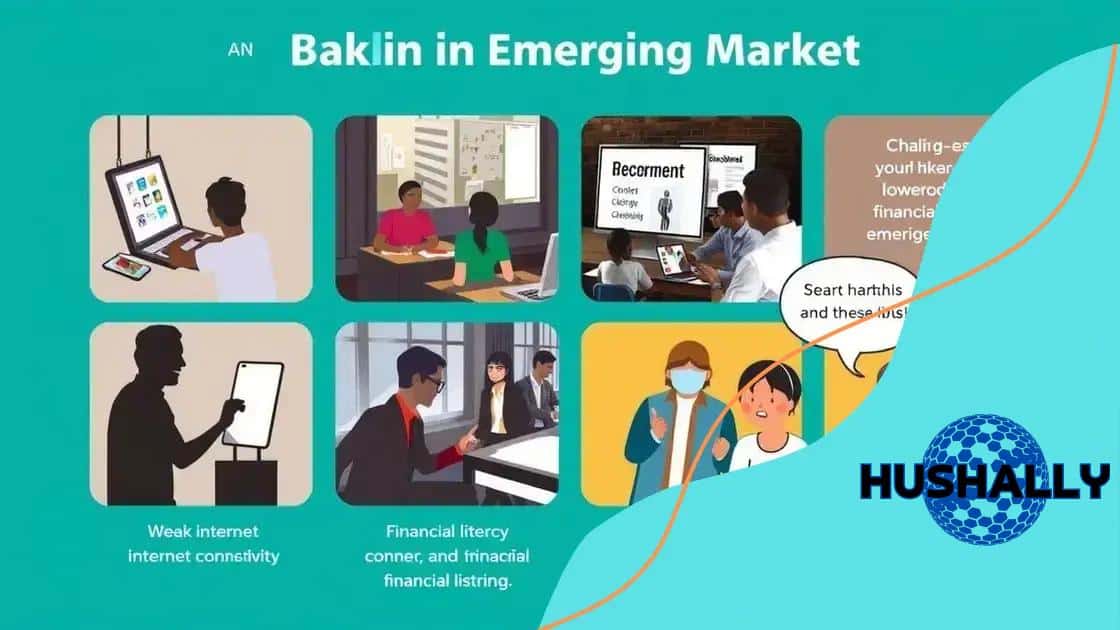Mobile banking expansion in emerging markets: a game changer

Mobile banking expansion in emerging markets enhances financial accessibility through technology, enables financial inclusion, and fosters innovative solutions while addressing challenges like infrastructure and security.
Mobile banking expansion in emerging markets is reshaping how people access financial services. Have you considered how this impacts daily life in these regions? Let’s dive into its significance.
Understanding mobile banking and its growth
Mobile banking is rapidly changing how individuals interact with their finances. It offers a convenient way to manage money right from a mobile device. With the rise of smartphones, mobile banking has become more accessible, enabling users in emerging markets to financially engage like never before.
The Growth of Mobile Banking
In recent years, mobile banking has experienced significant growth, especially in developing regions. It fills a gap where traditional banking services are often limited. One of the driving factors for this expansion is the increasing smartphone penetration.
Moreover, many people in emerging markets do not have easy access to physical bank branches. Thus, mobile banking serves as a powerful alternative. Users can perform various activities such as transferring money, paying bills, and checking account balances without having to visit a bank.
Key Benefits of Mobile Banking
- Convenience: Access banking services anytime and anywhere.
- Financial inclusion: Enables unbanked populations to participate in the economy.
- Cost-effective: Reduces the need for physical infrastructure and transaction fees.
Mobile banking also engages smaller businesses that can now accept mobile payments, leading to economic growth and stability. As consumer confidence rises, more individuals are willing to adopt mobile banking services.
Additionally, security measures have continually evolved, making mobile banking safer for users. Enhanced authentication methods and encryption help protect sensitive data, boosting trust in these digital services.
As mobile banking continues to grow, it also opens opportunities for financial literacy programs. These programs educate users about managing finances wisely, fostering a culture of savings and investment among new users.
Key players driving mobile banking adoption
Several key players are significantly influencing the adoption of mobile banking in emerging markets. These players are essential in developing technology and creating awareness about the benefits of mobile financial services. Each one plays a unique role in making banking accessible to all.
Telecom Companies
Telecommunications companies are at the forefront of this transformation. They leverage their existing infrastructure to provide mobile banking services. By partnering with banks, they enable users to easily access their accounts through mobile devices. This collaboration has broadened the customer base significantly.
Fintech Startups
Fintech startups are revolutionizing the financial landscape. They introduce innovative solutions to traditional banking challenges, such as high fees and accessibility issues. These companies often focus on creating user-friendly applications, making banking easier for everyone. Their emphasis on technology ensures that services are intuitive and appealing.
- Provide cheaper and faster transactions.
- Enhance user experience through appealing designs.
- Offer personalized financial services through data analytics.
Moreover, governments and regulatory bodies also play a vital role. They create policies that support mobile banking initiatives. By providing a legal framework, they encourage the growth of services. Regulatory bodies ensure that these services are secure and reliable, fostering trust among users.
Traditional banks are also adapting to this new landscape. To stay competitive, many are Developing their mobile banking platforms. They often collaborate with fintech firms to improve their services and reach a broader audience. This shift ensures that they remain relevant in a changing market.
Finally, non-governmental organizations (NGOs) support mobile banking by introducing programs that promote financial literacy. These programs educate communities on how to use mobile banking safely and effectively. Their involvement ensures that even the most vulnerable populations can benefit from these advancements.
Challenges faced by emerging markets in banking

Emerging markets experience unique challenges in the realm of banking. These hurdles can impede the growth and adoption of mobile banking services. Identifying these issues is essential for creating effective solutions.
Lack of Infrastructure
One major challenge is the lack of proper infrastructure. Many areas do not have reliable internet or mobile connectivity. This limitation can make it difficult for users to access banking services. When connectivity is weak or inconsistent, mobile banking apps often fail to perform correctly.
Low Financial Literacy
Another significant hurdle is low financial literacy among the population. Many individuals are not familiar with banking concepts or how to use mobile banking effectively. This lack of knowledge can discourage people from adopting new financial technologies. To overcome this, educational initiatives are necessary.
- Workshops and seminars can teach the basics of mobile banking.
- Community programs can provide hands-on training.
- Engagement with local leaders to promote the benefits of banking.
Regulatory constraints also complicate the situation. Different countries have varying rules that govern banking operations. These regulations can sometimes hinder innovation or create barriers to entry for new services. Ensuring compliance can be time-consuming and costly for financial institutions.
Security concerns pose another major challenge. In many emerging markets, fraud and cybersecurity threats can deter users from trusting digital banking. Individuals worry about the safety of their money and personal information. Strengthening security protocols is crucial for gaining users’ trust.
Finally, cultural factors can affect mobile banking adoption. Some communities may prefer traditional banking methods. Convincing these individuals to transition to mobile services requires targeted awareness campaigns that address cultural beliefs and practices.
The role of technology in enhancing mobile banking
Technology plays a crucial role in enhancing mobile banking, making it more accessible and efficient for users around the world. Innovations in technology have transformed how banking services are delivered, allowing for greater convenience and security.
Innovative Applications
Mobile banking applications are at the heart of this transformation. These apps provide a user-friendly interface where customers can access their banking services easily. Features like real-time notifications help users stay informed about their account activity. In addition, many apps now include budgeting tools, which assist users in managing their finances effectively.
Enhanced Security Features
As mobile banking grows, so do the security concerns associated with it. To combat these worries, technology continuously improves security measures. For example, biometric authentication, such as fingerprint and facial recognition, provides an added layer of protection. These methods are not only secure but also convenient, allowing users to log in without remembering complex passwords.
- Encryption protects sensitive data from unauthorized access.
- Multi-factor authentication adds another layer of security.
- Fraud detection algorithms monitor transactions for suspicious activity.
Cloud technology also plays a vital role in mobile banking. It allows for scalable solutions that can adapt to the increasing number of users. With cloud computing, banks can store vast amounts of data securely and access it from anywhere. This flexibility is essential for improving service efficiency.
Artificial intelligence (AI) and machine learning are revolutionizing customer service in mobile banking. Chatbots assist customers 24/7, answering questions and solving issues instantaneously. This technology not only improves user experience but also reduces operational costs for banks.
Finally, technology enables seamless integration with various financial services. Users can easily link their bank accounts with payment platforms, investment apps, and digital wallets. This connectivity creates a holistic financial ecosystem that enhances user engagement and satisfaction.
Future trends in mobile banking for emerging economies
As mobile banking continues to grow, several exciting future trends are emerging in the landscape of banking for emerging economies. These trends indicate how technology and user demands will shape the future of financial services.
Increased Use of Artificial Intelligence
One major trend is the increased use of artificial intelligence (AI). AI can enhance user experience by providing personalized services. For instance, chatbots can assist customers in real-time, solving issues quickly. They can also analyze spending habits, helping users manage their finances better.
Expansion of Financial Inclusion
Another significant trend is the expansion of financial inclusion. More financial institutions are recognizing the value of serving unbanked populations. Mobile banking platforms will likely offer tailored products that cater to these groups, ensuring they have access to essential financial services.
- Microloans to support small businesses.
- Low-cost savings accounts.
- Affordable insurance products.
Blockchain technology is also gaining traction in mobile banking. It offers enhanced security and transparency, which are crucial for user trust. As blockchain becomes more mainstream, it could facilitate easier cross-border transactions, making it easier for users in emerging markets to send and receive money.
Moreover, mobile payment solutions are on the rise. As more users adopt smartphones, payment apps will likely become more popular. These apps provide a convenient way to transfer money and pay for goods and services, fostering a cashless society.
Finally, partnerships between banks and tech companies will lead to innovative solutions. Such collaborations can help institutions leverage technology to enhance their services. By embracing tech advancements, banks can better meet customers’ needs and keep up with the changing landscape of mobile banking.
FAQ – Frequently Asked Questions about Mobile Banking Expansion in Emerging Markets
What are the main benefits of mobile banking in emerging markets?
Mobile banking increases accessibility to financial services, helping unbanked populations manage their finances easily.
How does technology enhance mobile banking services?
Technology improves user experience with innovative apps, AI chatbots, and enhanced security features like biometric authentication.
What challenges do emerging markets face with mobile banking?
Challenges include lack of infrastructure, low financial literacy, security concerns, and regulatory constraints.
What future trends can we expect in mobile banking?
Future trends include greater AI usage, expanded financial inclusion, blockchain adoption, and more seamless integration with payment solutions.





